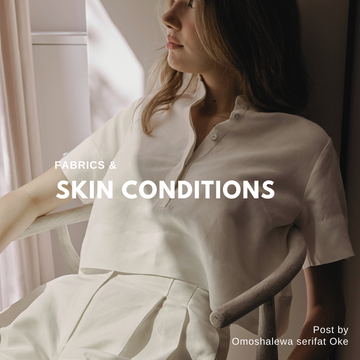Post by Omoshalewa serifat Oke
Skin Has Memory And Fabric Leaves Traces
Most people think of clothing as a protective outer shell, a buffer between their body and the outside world but few realize that the interaction between skin and fabric is more than just surface-level, it’s a two-way communication. Your skin has memory, and every fiber you wear leaves behind a trace, whether it’s supportive or harmful.
This is not a metaphor. It’s biological science.
1. Skin: Your Body’s Most Absorbent Barrier

Skin is not just a passive shield. it’s an active organ. It regulates temperature, responds to stress, and absorbs environmental inputs. According to dermatological studies, skin absorbs up to 60% of what it comes in contact with, depending on molecular size, skin condition, and temperature. What does this mean for clothing? It means that the fabrics you wear daily are part of your internal health environment.
2. Traces Left by Fabric: Chemical and Biological Impact
 a. Chemical Residues
a. Chemical Residues
Synthetic and conventionally treated fabrics contain residues from dyeing, bleaching, softening, and finishing processes. Common culprits include:
-
Formaldehyde (anti wrinkle)
-
Phthalates (used in plastics and print designs)
-
Azo dyes (common in cheap fashion dyes, linked to allergies and cancer)
These substances don’t just sit on the surface. They can be absorbed into the skin, especially when combined with heat, sweat, and friction.
b. Microplastic Fibers
Polyester, acrylic, and nylon release microfibers with every wash and every wear. These particles can irritate sensitive skin, clog pores, and enter the body through skin contact or inhalation.
c. Pathogen Retention
Tightly woven synthetics trap moisture, creating a perfect breeding ground for bacteria and fungi. This can lead to:
-
Yeast infections
-
Body acne
-
Folliculitis (inflamed hair follicles)
3. The Skin Remembers
 Dermatologists report that repeated exposure to irritants in fabric can lead to sensitization, where the skin becomes more reactive over time. What begins as mild itching or redness can evolve into:
Dermatologists report that repeated exposure to irritants in fabric can lead to sensitization, where the skin becomes more reactive over time. What begins as mild itching or redness can evolve into:
Children, pregnant individuals, and people with autoimmune conditions are particularly vulnerable.
4. The Role of Natural and Organic Fabrics

Natural fibers like organic cotton, linen, hemp, and bamboo are not just “better alternatives” they actively support healthier skin function.
Why?
-
They’re breathable and allow skin to self-regulate.
-
They’re hypoallergenic by nature.
-
They lack harmful residues due to non-toxic farming and processing methods.
Wearing these fabrics means giving your skin a neutral, clean environment, allowing it to regenerate, detox, and remain unburdened by synthetic friction or chemical stress.
5. Real life Evidence
Recent clinical case studies show that patients with unexplained skin conditions experienced:
-
50–70% improvement in symptoms after switching to untreated natural fibers
-
Less inflammation and itching within two weeks
-
Better sleep and comfort, particularly in organic nightwear and bedsheets
This shows that fabric isn't just about fashion or sustainability. It's about biocompatibility working with your body, not against it.
6. What You Can Do Now
Here are steps to align your wardrobe with your skin health:
-
Choose GOTS-certified or OEKO-TEX certified fabrics
-
Wash new clothes before wearing (to remove residues)
-
Avoid synthetic blends labeled “wrinkle-free,” “anti-odor,” or “performance fit”
-
Prioritize comfort, breathability, and function over appearance
Your skin will remember the change.
Conclusion
Skin has memory and like all memory, it records both harm and healing. Every fabric you wear is part of your body’s daily dialogue. So choose the ones that listen, support, and protect, because your wardrobe is not just a mirror of your style. It’s a legacy your skin carries for a lifetime.
References
American Academy of Dermatology – Contact Dermatitis from Clothing
Textile Exchange – Impact of Microplastics in Clothing
World Health Organization (WHO) – Formaldehyde and Health Effects
Journal of Clinical Dermatology – Biocompatibility of Natural Fibers






